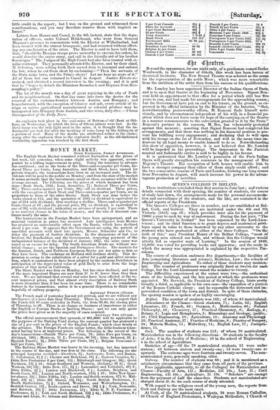QUEEN'S COLLEGES IN IRELAND.
These institutions concluded their first session in June last ; and various details connected with their opening, the number of students, the course of study laid down, the arrangements made for the personal accommoda- tion and surveillance of the students, and the like, are contained in the- official reports of the Presidents.
The Queen's Colleges are three in number and are established at Bel- fast, 'Cork, and Galway. They are instituted under the 8th and 9th Victoria (1845) cap. 66 ; which provides inter alia for the payment of 70001. a year to each by way of endowment. Dining the last year, " The -Queen's University in -Ireland" has been organized by the Lord-Lien- tenant ; and its -chief function is to grant degrees and academical privi- leges equal in value to those 'bestowed by any other university -to the students who have graduated at either of the three Colleges. "-On the faith of this," says President Henry of the Belfast College, "-most -of the young men entered our halls, and without this the Colleges would utterly fail as superior seats of learning." In the session of 1849, 12,0001. was voted for providing books and apparatus ; and the mode in Which the money was appropriated is explained by the respective Pre- sidents.
The course of education embraces five departments,--the Acuities of Arts (comprising literature and science), Medicine, Law.; the schools of Engineering and Agriculture. To either of these Audents may 1:nation- -late. The number of professors was -originally fixed at -twelve far each College, but the Lord-Lieutenant-raised the number to twenty.
The difficulties experienced at the outset were two,---the -unfinished state of the buildings, and the late period at -which the professors-were appointed. Mr. Berwick, the President of -Galway College, hints pretty broadly a third, as applicable to his own case—the opposition of a portion of the Roman Catholic clergy ; -and -he superadds the distressed antlini- poverished condition of-the town and district. in spite of these obese*, the opening session is spoken of as highly encouraging.
...Belfast. The number of students was 192; of whom 85 matrieulate4.
Attendance at the Classes—Greek students, 71; .Latin, 63; English Literature, 52 ; French, 62 ; German, 6.; Mathematics, $6; Natural Philosophy, 48; Chemistry, 37 ; Practical Chemistry, ; Zoology, 4 ; Botany, 8 ; Logic and Metaphysics, 3 ; Mineralogy and Geology , (public, 10 ; 'Civil -Engineering, 10 ; Agriculture, 10 ; Anatomy and Fhyriolegy 26; -Practical Anatomy, 27 ; Practice of Medicine, 9 ; Fracticeef Surgery, 24 ; Materia Medics, 11; Midwifery, 14,; English Law, 17.; Jurispru- dence, 11.
Cork. The number of students was 115; of -whom 70 matrienlateil. Matriculation ran in the following directions : '50 students in the faculty of .Arts ; 6 in the faculty of Medicine; 10 in the _school of 'Engineering 4 in the school of Agriculture.
Statistics of age—Of the 70 matriculated students, 12 were under sixteen; 43 between sixteen and twenty-one; 15 were twentyone or upwards. The .extreme -ages were fourteen and twenty-seven. The non- matriculated were, generally speaking, older.
Galway. The number of students was 68 ; and it is mentioned as-a satisfactory circumstance that they came from all parts of the ,provinee.
Fees (applicable, apparently, to all fhe Colleges) for Alatrioulation and Classes—Faculty of Arta, 111. ; Medicine, 111. 10s.s Law, 22 ; Cavil Engineering, 1I1. 10.. ; Agriculture, IL 10s. ." Scholars" are exempt from the payment of half the class-fees. Students not matthadatedane charged about 2/. 6s. -for each course of study attended.
With regard to the religious creed of the young men, the-reports from Cork and Galway are the most exact.
At Cork, of the 70 matriculated students, 38 were Roman Calheillos, 26 Church of England Protestants, 4 Wesleyan Methodists, 1 Church of Scotland Presbyterian, 1 Independent Protestant. The 45 non-matricu- lated students present the like proportions. At Galway, of the 68 students, '38 were roman Catholics, 22 of the Established Church, and -8 of the Presbyterian Church.
At Belfast, "the general registry presents a 'fair proportion of the different churches; and the scholarship and the class-prizes at the end of the session were obtained by members of the Established Church and of the General Assembly, by Roman Catholics, non-subscribing Presby- terians, Covenanters, Methodists, and independents." From these details it is evident that should the Synod of Thurlos suc- ceed in its hostile object, more than half the students attending the Cork and Galway Colleges will be withdrawn. A defined matriculation course is laid down, requiring in the candidate considerable classical and mathematical attainments, as well as a know- ledge of history, composition, geography, and arithmetic. The courses for graduation include the branches usually followed in other colleges, with the addition of at least one modern language, and proficiency in chemistry and natural history. Scholarships are attached to all the departments: 241. is the prevailing amount. They can only be held for one year, but the holder may .again compete. Prizes of 1001. value are distributed in each of the Colleges. The religious instruction and superintendence of the students are pro- vided for by the appointment of three clergymen, called Deans of Resi- dence. These embrace Church of England, Roman Catholic, and Presby- terian ministers. Licensed boarding-houses are appointed for the accom- modation of students who do not reside with their parents or guardians ; and they are placed under the superintendence of the Deans. Those who live with parents or guardians are also cared for. According to the Deans' reports, the young men 'have conducted themselves exceedingly well.



























 Previous page
Previous page